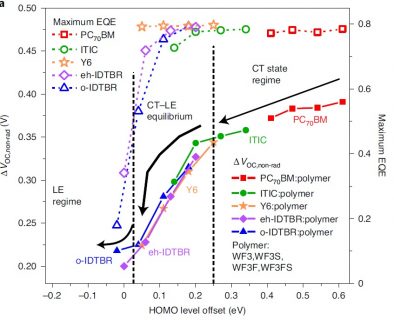Andrej, Larry and Thomas publish a set of novel material design rules to extend OPV efficiency beyond 20 %
Andrej´s paper on the limitations of organic solar cells just went online in Nature Energy and got advertised in the News & View section of by a very profound comment from Tracey Clarke (thank you Tracey!). Andrej, Thomas and Larry went deep to understand the limiting factors enabling efficient free charge generation in parallel to keeping voltage losses as small as possibly. Not surprisingly, matching the energy levels of the donor and acceptor guarantees to reduce voltage losses. However, at such negligible energetic offset, one would expect that charge generation is breaking down.
In this paper we have shown at the hand of non-fullerene acceptor solar cells how to work around that limitation. As a surprisingly simple design criteria, we could evidence that a long exciton lifetime is key to guaranteeing efficient charge separation even at negligible energy offsets. Of course, there must be limitations. Especially near IR absorbers are known to suffer from the energy gap law, which reduces radiative recombination at the hand of non-radiative relaxation. However, some of the novel NFAs, and especially the Y6 derivatives, seem to be more relaxed from the energy gap law, and we indeed found exciton lifetimes of up to 1 ns. Of course, one has to keep in mind that solid state NFA films are still far away from PLQY of 100 %. As such, small changes in PLQY due to the energy gap law may not be limiting for the current generation of materials.
Having understood charge generation at negligible energy offsets has led us to postulate this novel design criteria for the next generation of OPV materials. The focus is on materials that have a particularly long exciton lifetime. Most exciting – measuring the exciton lifetime does not require sophisticated setups. A simple transient photoluminescence measurement is sufficient and opens the venue towards high throughput design and characterization of the next generation of materials.

